Kings Mountain State Park
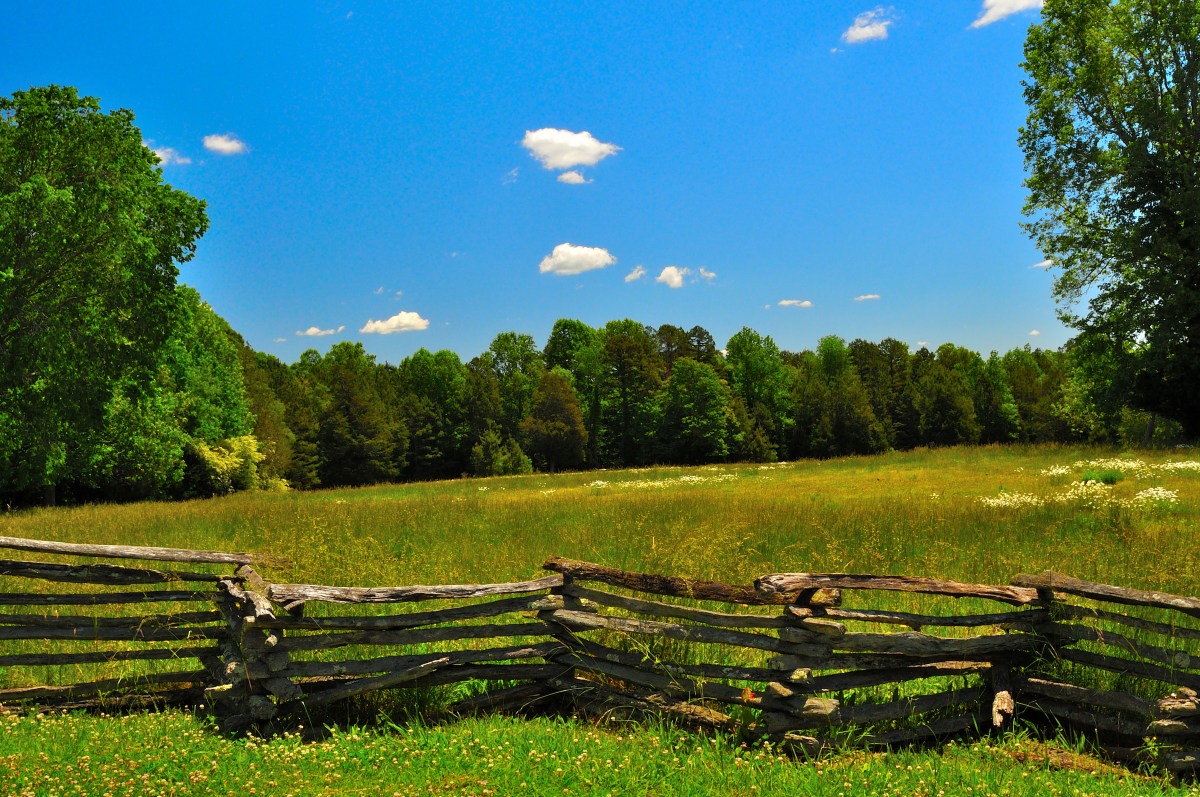
Located in northern South Carolina just a short drive from the site of the 1780 Battle of Kings Mountain, you’ll find one of South Carolina’s 16 State Parks built during the Great Depression by the Civilian Conservation Corps also known as Roosevelt’s Tree Army.
Visiting Kings Mountain State Park
Renowned as a great place for horseback riding, Kings Mountain State Park is also a beautiful spot for camping, hiking, and it even affords visitors a chance to step back in time at it’s Living History Farm (an open air museum).

Hiking
Over 30 miles of hiking trails crisscross the park. Some trails even feature backcountry campsites. The hiking trails built by the Civilian Conservation Corps are still in use today, and some even connect to the adjacent Kings Mountain National Military Park as well.
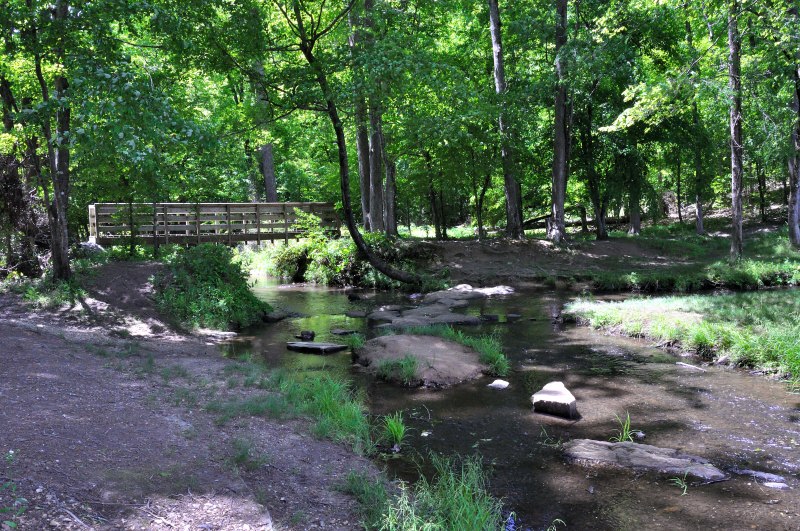
If that’s still not enough hiking for you, the Ridgeline Trail connects to nearby Crowders Mountain State Park in North Carolina. So you get even more trails to explore including some of the best views in the area at Kings Pinnacle.
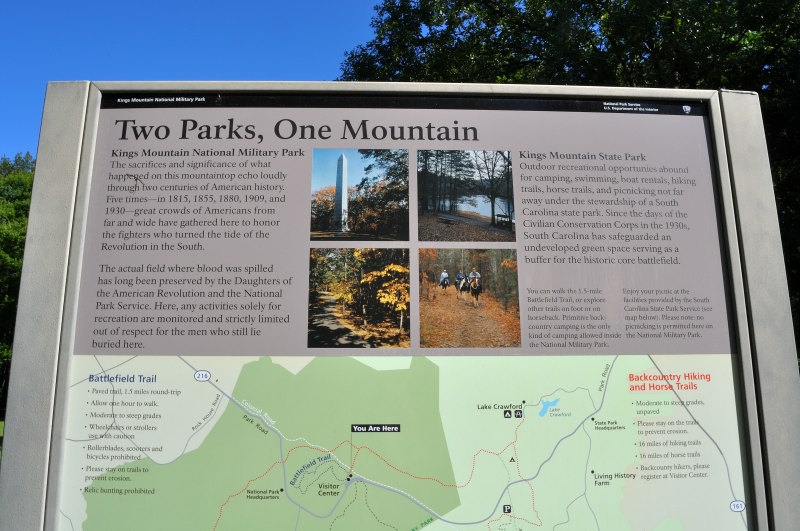
Horse lovers will appreciate the fact that most of the trails in the park allow horseback riding alongside hiking. The park has over 30 miles of horse accessible trails as well as campsites with individual corrals in the equestrian camping area.
Lake Crawford

The Lake Crawford day use area built by the Civilian Conservation Corps is no longer used for swimming and there’s no beach access to the lake. The bathhouse has fallen into disrepair, but the stonework surrounding it is still as impressive as ever.

But if you take a short walk past the dam, you’ll find one of the nicest spots anywhere. There aren’t any picnic tables, but that shouldn’t stop you from throwing down a blanket and having an old fashioned frontier style picnic.

Fishing is allowed along the shore and boats can be rented to go out onto the lake. Picnic shelters are available not too far away near the RV campground and individual tables can be found around the lake.

Camping
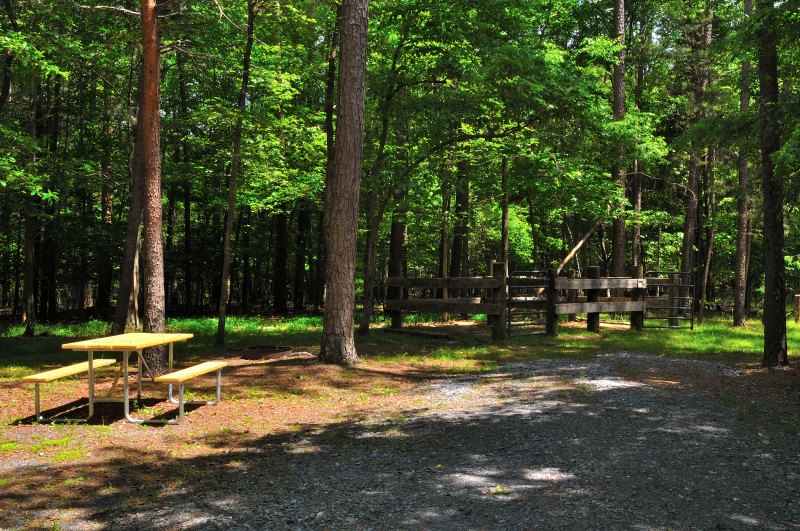
An RV campground is located on the other side of the large parking lot at Lake Crawford. The facilities are modern and well maintained, and there is a small park store.
Equestrian camp sites are available nearby. They include both RV and primitive camp sites.
Backcountry campsites are scattered along the Kings Mountain National Recreation Trail which runs for 16 miles through the State Park as well as the National Military Park.
Living History Farm

In a nod to the farmers who once lived in what would become the state park, a replica of a 19th Century Yoeman Farm stands not far from camps Cherokee and York in the state park.
Yoeman farmers were poor but they owned their own land. They were forced to be self sufficient, so as well as growing their own food, they had to be able to take care of everything else on the farm themselves.

It wasn’t uncommon for yoeman farmers to not only have a house and a barn, but a cotton gin, blacksmith shop and weave shop as well. All of those buildings and some farm animals are at Kings Mountain Living History Farm.
Starting in the 1970’s old buildings from area farms were brought here. Over the decades, the site has grown to be the high point of any visit to Kings Mountain State Park.

The farm can be reached by either a trail from Lake Crawford or the auxiliary park road leading to Camp York.
The privy located in the parking lot has a history all it’s own. It was originally built as a station for Civilian Conservation Corps guides who gave battlefield tours at the military park. Since it was constructed to look like a pioneer’s log cabin, it fits right in with the other buildings in the living history farm.

Self guided tours are available and interpretive signage explain the importance of the various buildings and give a glimpse of life around this area in the post Revolutionary era.
For details on our visit check out our Kings Mountain Field Report
Final Thoughts About Kings Mountain State Park
Camping and equestrian activities seem to be the main activities here. The RV campground is clean and well maintained with all the extras you’d expect. The park store is small and carries a few essentials in case you run out.
It’s also one of the few places in the area to offer equestrian camping and horseback trails.
If you’re wanting to take in some of the hiking trails, be sure to give yourself plenty of time. All of the trails are either really short or in the 15 mile range with nothing in between. The interesting thing about the trail system is that it not only connects the trails in Kings Mountain National Military Park, but Crowders Mountain State Park in North Carolina as well. So if you’re camping in the park, you’ll never run out of hiking trails to enjoy.
Keep this connection in mind as Crowders Mountain gets really busy and at peak times can be impossible to find a parking place. Knowing you have the option of coming to Kings Mountain could save your day out.
There really isn’t a day use area of the park anymore. The Lake Crawford area has fallen into disrepair and hasn’t been open for swimming for over 20 years. But some folks still visit to spend the day fishing around the banks.
For lots of people the Living History Farm will be the highlight of their visit, and if you’re visiting the adjacent Battleground Park, it’s worth the extra stop.
Kings Mountain a story Rebirth
In the decades between the American Revolution and the Great Depression, this area of York County, South Carolina was primarily farmland. In 1780 there were just a few small farms surrounded by a mature hardwood forest. Over time, more and more farms sprung up, and much of the forest was cleared for crops and fields.

The majority of these family farms were less than 200 acres, and by the 1930’s soil erosion was taking it’s toll. As the forest was cleared and farmland depleted, everyone began to realize that farming was becoming less profitable every year. Unfortunately, the poor family farmers were stuck on that had become unworkable as they had nowhere else to go.
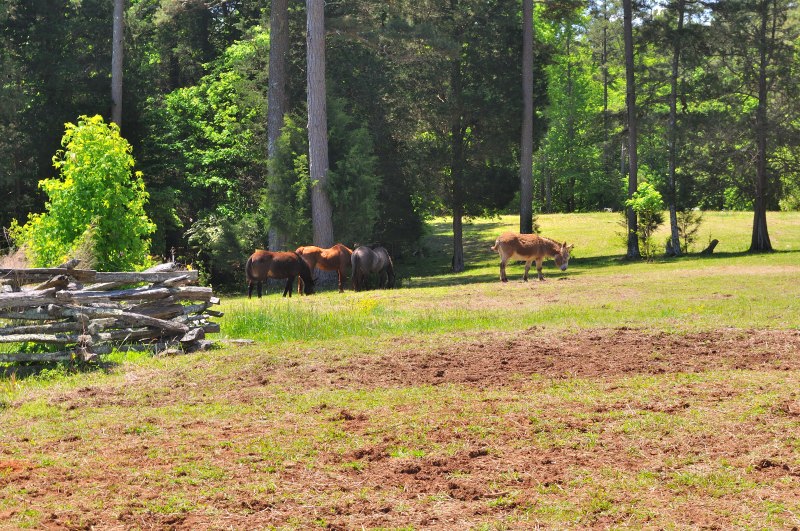
After Congress authorized the War Department to develop a Military Park at the site of the Revolutionary War battle, the National Park Service (NPS) was brought in to do the work. After assessing the situation, the Park Service decided to develop the land as a Recreation Demonstration Area (RDA).
Recreation Demonstration Areas
RDA’s were a new concept where sub-marginal farmland would be converted into low-cost recreational facilities the type of which were sorely needed by the textile workers of the area.
Typically, RDA’s included both day use areas and facilities for organized summer camps where poor children could enjoy outdoor activities. Only 45 RDAs were built in the entire nation with 2 being in South Carolina.
Multiple New Deal Programs Working Together at Kings Mountain
In 1935, The National Park Service only had the original 40 acres of battlefield land they received from the War Department. In order to acquire the rest of the acreage needed to build the military park and the RDA, the Resettlement Administration (RA) was brought in.

The RA was a Second New Deal program with a two fold mission. One was to provide relief to struggling farmers working worn out land, just like the farmers around Kings Mountain. The land would be purchased and the farmers relocated. Then working with the National Park Service, the sub-marginal farmland would be transformed into new growth forests and recreational facilities.
Civilian Conservation Corps Gets to Work
By the Summer 1935, it was time to get to work. Two Civilian Conservation Corps (CCC) camps were established. One would work on the military park at the site of the battlefield, the other would build the state park.
The CCC was a relief program that brought in young unmarried men from where ever available. They received room and board in the camps as well as a small weekly wage. The majority of the wage, they were expected to send home to their families.
Known as Roosevelt’s “Tree Army”, the CCC not only provided jobs for countless unemployed young men during the Depression, but it relieved the burden on their families because they would have less mouth to feed. It also provided extra money to the families in the form of the money the members would send home every month. The young men not only learned a trade, but also helped build state and national parks all over the country.
Initially all the workers at Kings Mountain were with the CCC, but by 1937 additional workers under the Emergency Relief Act (ERA) were brought in. In contrast to the CCC, ERA workers were local and tended to live at home. Trucks would pick them up every day, taking then to the worksite and delivering them home every night.
Kings Mountain State Park was designed around two lakes both constructed by the CCC.
Lake Crawford
Lake Crawford formed the focal point of the day use area of the park. This was an area where local workers could enjoy their free time having picnics, swimming, or just relaxing on the shore.
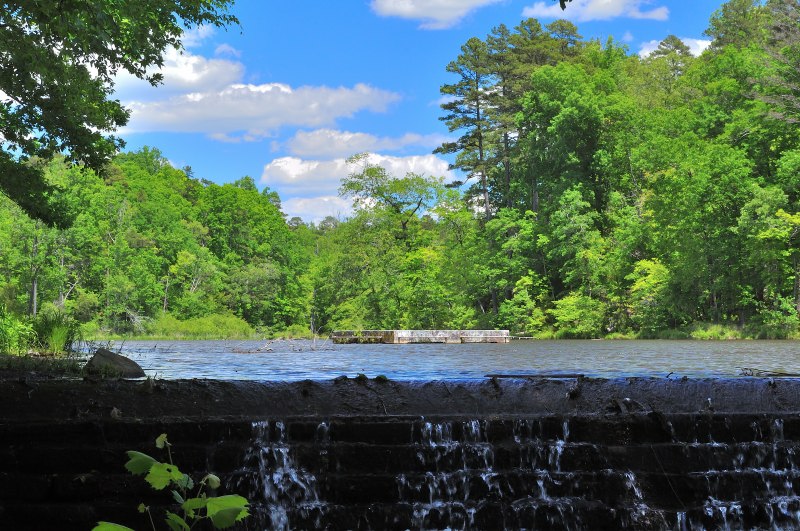
The lake formed shortly after the completion of the dam in 1937. The stones of the dam are laid out in a stair-step configuration allowing water to overflow from the lake like a waterfall.
The Lake Crawford area was completed in 1939 when the swimming platform and bathhouse were built. Set on the side of a hill, the bathhouse features impressive stone work all along the outside. From a 6 foot tall retaining wall to large stone steps leading down to the bathhouse and then on the other side down to the lake. Flowerbeds were planted around the bathhouse featuring native species.
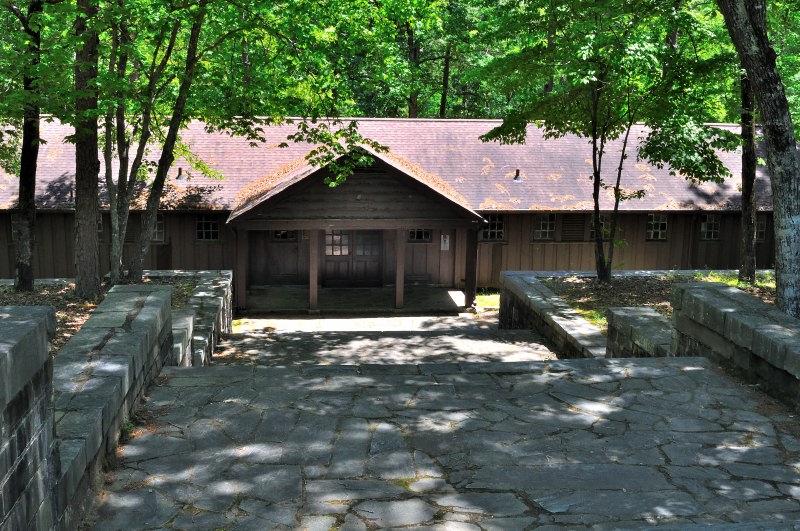
Lake York
Lake York is the larger of the two lakes and was designed as the central feature of the two organized camps. At Camps York (1938) and Cherokee (1941), the CCC built all the buildings needed for kids to enjoy summer camp.
From mess halls, to cabins and latrines, and everything else needed for the RDA’s mission of providing “underprivileged children, farm clubs, and groups from the cities [a way to] to enjoy a healthful outdoor life during the summer months, at a low cost, under proper supervision” was constructed at the camp sites.
Legacy of Kings Mountain State Park
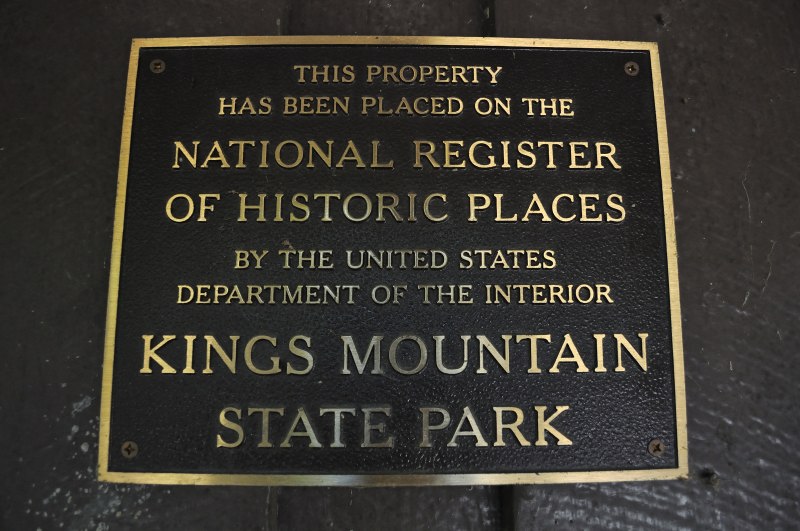
The buildings constructed by the CCC at Kings Mountain are also prime examples of “parkitecture” which typified National Parks Service construction in the 1930’s and 40’s. Local materials were used and buildings designed to blend into the natural surroundings and not stick out. Even the park roads were designed not to stand out, following the natural contours of the land.
Many of those improvements made by the CCC are still in use today.
Camp Cherokee is a YMCA summer camp and not accessible to park visitors. It continues the mission of the Recreation Demonstration Area by offering children a taste of “outdoor life during the summer months”. Campers come from not only South Carolina but surrounding states as well, and financial assistance is available to make summer camp affordable to more children.
Camp York likewise isn’t accessible to park visitors. The buildings are rented out to large groups looking for a retreat in a rustic setting.
Camp York has the distinction of being the model for similar projects around the country throughout the Depression era. The camper’s cabins, counselor’s cabins, and latrines were all included in the National Parks Service’s design encyclopedia.
Most of Lake York is closed off behind gates to the two organized camps. There is a small spot where you can rent a boat to take out onto the lake.
NOTE

The South Carolina Parks Service is seeking donations to renovate the CCC bathhouse and return the area around Lake Crawford to use. If you would like to help click the link below.
Kings Mountain State Park was formally turned over to the state of South Carolina in 1944. During it’s time in the NPS, it provided the community a much needed resource during the dark days of the Depression and World War II. In the years to come, it remained an important asset to the community, providing group camps, a public swimming beach, bathhouse and picnic area.
Fast Facts About Kings Mountain State Park
| Type: | State Park |
| Admission: | $3 adults; $1.50 SC seniors; $1 children age 6-15; age 5 & younger free |
| Location: | 1277 Park Rd, Blacksburg, SC 29702 |
| Website: | https://southcarolinaparks.com/kings-mountain |
| Phone | (803)222-3209 |
Things to do: RV Camping, Primitive Camping, Equestrian Camping, Hiking, Horseback Riding, Fishing, Picnicking




